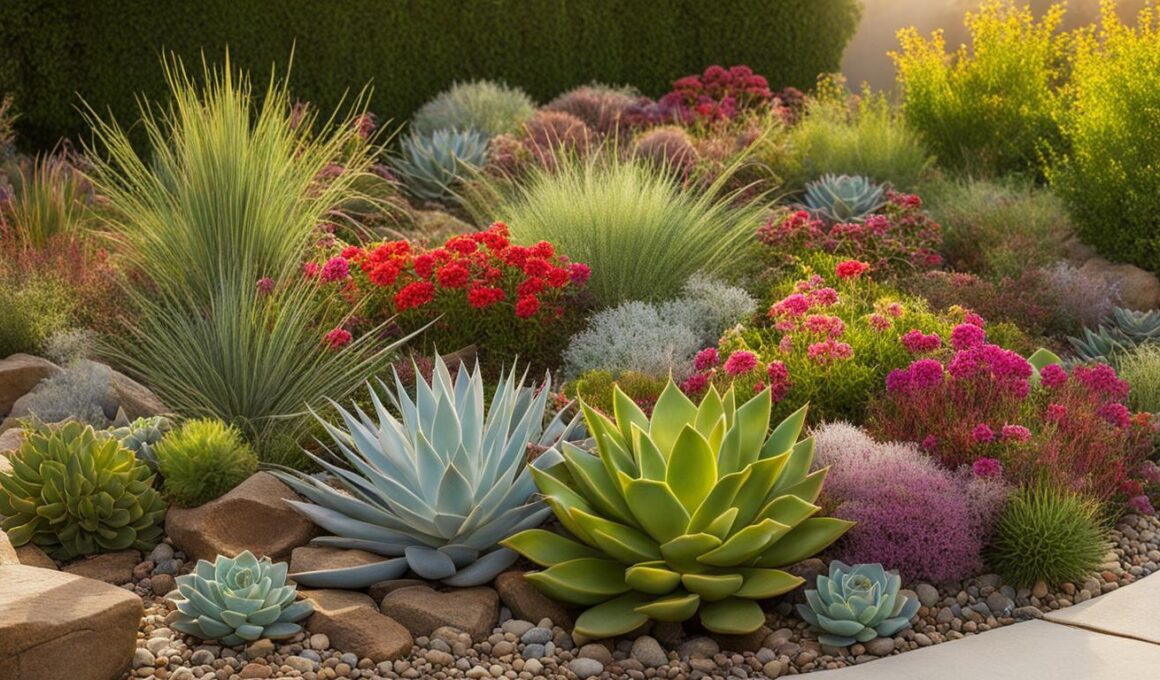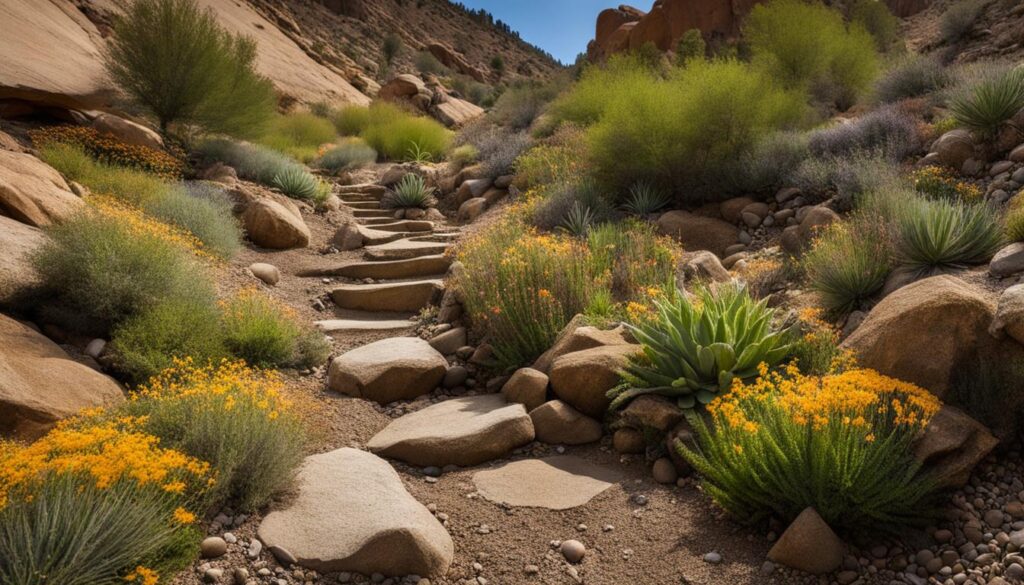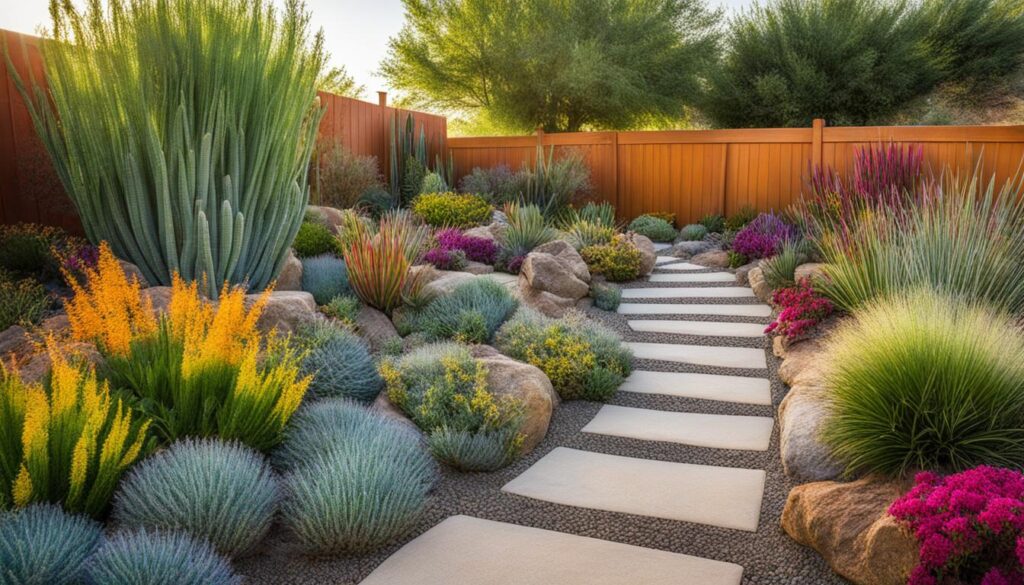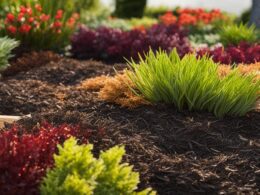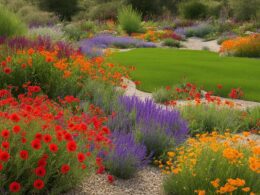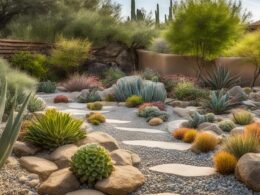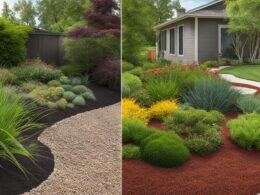Xeriscaping is a landscaping technique that aims to reduce or eliminate the need for irrigation, making it perfect for the eco-conscious gardener. By incorporating low-water plants into your xeriscaping design, you can enhance your landscape while conserving water.
Are you ready to create a sustainable and visually appealing landscape? In this article, we will explore a variety of low-water plants that are ideal for xeriscaping designs. Whether you have steep slopes, sunny conditions, or need plants for groundcover and borders, we’ve got you covered. Get inspired and transform your outdoor space!
Key Takeaways:
- Xeriscaping is an eco-friendly landscaping technique that aims to reduce the need for irrigation.
- Low-water plants are essential for successful xeriscaping designs.
- There are specific low-water plant options for different xeriscape landscaping challenges, such as steep slopes, sunny conditions, and groundcover.
- Low-water plants for xeriscaping can also be beautiful flowering plants that attract pollinators.
- By incorporating low-water plants into your xeriscaping design, you can create a lush and vibrant landscape while minimizing water usage.
Xeriscape Plants for Steep Slopes
Landscaping steep slopes can present unique challenges, but with the right choice of plants, you can create a beautiful and sustainable xeriscape design. When it comes to steep slopes, it’s essential to select drought-tolerant plants that can thrive in these demanding conditions. Here are some excellent options:
- Bearberry: With its low spreading habit and evergreen foliage, Bearberry is an ideal choice for preventing soil erosion on steep slopes. It also produces bright red berries that add visual interest.
- Shore Juniper: This hardy evergreen shrub can tolerate full sun and poor soil conditions, making it perfect for steep slopes. Its dense foliage provides excellent coverage, and it requires minimal maintenance.
- Sedum ‘Autumn Joy’: Known for its stunning pink blooms and succulent leaves, Sedum ‘Autumn Joy’ is a popular choice for xeriscaping. It is drought-tolerant and can thrive on steep slopes, adding texture and color to your landscape.
- Thyme: Thyme is not only an aromatic herb but also an excellent groundcover for slopes. Its spreading habit forms a dense mat that helps reduce soil erosion, and its small purple flowers add a touch of beauty.
These plants not only have low water requirements but also have the ability to grow horizontally, which helps stabilize the soil on steep slopes. Incorporating them into your xeriscape design will not only enhance the visual appeal but also contribute to water conservation.
Drought-Tolerant Plants for Challenging Locations
When dealing with steep slopes, it’s important to consider the specific challenges they present. These include limited water retention, increased erosion potential, and difficult access for maintenance. Fortunately, there are many plants that can thrive in these challenging locations. By selecting drought-tolerant species with deep and spreading root systems, you can help prevent erosion, stabilize the soil, and create a visually appealing landscape.
“Steep slopes present unique challenges in landscaping, but with the right selection of drought-tolerant plants, you can create a beautiful and environmentally-friendly xeriscape design.”
Remember, it’s crucial to properly prepare the soil and provide initial irrigation to help these plants establish their root systems. Once established, they will require minimal watering, making them perfect for xeriscaping on steep slopes. Consider incorporating these plants into your landscape to create a sustainable and visually stunning design.
Drought-Tolerant Plants for Sunny Conditions
If your landscape is characterized by sunny conditions, there are plenty of drought-tolerant plants that can thrive in these environments. These plants not only require minimal water but also add vibrant colors to your landscape design.
One excellent choice is Yucca, a versatile plant known for its sword-shaped leaves and tall flower spikes. Yucca is extremely drought-tolerant and can withstand hot, sunny conditions without wilting. Its unique shape and texture add architectural interest to your landscape.
“Yucca is a stunning plant that can withstand even the harshest sunny conditions. Its impressive foliage and ability to conserve water make it the perfect choice for xeriscape landscaping.”
Another great option is Ice Plants, which are low-growing succulent plants that produce colorful flowers. Ice Plants are well-suited for sunny areas and are often used as groundcover due to their spreading habit. They come in a range of vibrant colors, such as pink, purple, and yellow, adding a burst of color to your xeriscape design.
Russian Sage is another popular choice for sunny xeriscape landscaping. This perennial plant features delicate silver-gray leaves and produces tall, airy spikes of purple-blue flowers. Russian Sage is not only drought-tolerant but also attracts pollinators like bees and butterflies to your garden.
If you’re looking for a plant that can provide vibrant blooms all year round, Bougainvillea is an excellent choice. This tropical plant is known for its bright and showy flowers that come in various hues, including pink, orange, red, and purple. Bougainvillea thrives in full sun and can tolerate drought conditions, making it an ideal addition to your xeriscape garden.
Low-Water Plants for Groundcover and Borders
Groundcovers and border plants are essential elements in xeriscape gardening, providing both functionality and aesthetics to your landscape design. These plants not only help to reduce water usage but also create a visually appealing and cohesive look. Here are some excellent low-water plants that are ideal for groundcover and borders:
Pachysandra procumbens: This evergreen groundcover plant thrives in partial shade and has attractive green leaves with white flowers in spring. It is a low-maintenance plant that requires minimal water once established.
Ophiopogon japonicus: Also known as mondo grass, this plant forms dense clumps of grass-like foliage and produces small spikes of white or purple flowers. It is drought-tolerant and adds texture and interest to borders and pathways.
Oxalis triangularis: Commonly referred to as purple shamrock, this low-growing plant features beautiful purple leaves that add a splash of color to your garden. It is a hardy and drought-tolerant plant that spreads quickly, making it an excellent choice for groundcover.
Juniperus conferta: This prostrate evergreen shrub is perfect for groundcover and borders, as it forms a dense mat of blue-green foliage. It is extremely drought-tolerant and requires minimal water once established.
These low-water plants not only conserve water but also offer various textures, colors, and forms, enhancing the overall appeal of your xeriscape garden. Incorporating them into your groundcover and border areas will create a vibrant and sustainable landscape that requires less maintenance and watering.
Enhance Your Xeriscape Garden with Colorful Low-Water Plants
When it comes to xeriscape gardening, low-water plants are a fantastic choice for adding color to your landscape. Here are a few more options to consider:
- The vibrant blooms of Gaillardia ‘Arizona Sun’ will add a splash of red and yellow to your xeriscape garden.
- Penstemon ‘Husker Red’ features deep burgundy foliage and stunning tubular flowers in shades of pink and purple.
- Santolina chamaecyparissus, also known as cotton lavender, offers silvery-gray foliage and small yellow flowers that add texture and contrast to your garden.
These colorful low-water plants not only thrive in drought conditions but also attract pollinators such as bees and butterflies, adding life and movement to your garden. By incorporating them into your xeriscape design, you can create a visually stunning and ecologically friendly landscape.
Drought-Tolerant Flowering Plants for Xeriscaping
Who says xeriscaping can’t have beautiful flowers? Incorporating drought-tolerant flowering plants into your xeriscape design is an excellent way to add pops of color while conserving water. These plants not only thrive in arid conditions but also attract pollinators such as bees and butterflies, creating a vibrant and sustainable landscape.
One stunning option for xeriscaping is Salvia sonomensis, also known as the Sonoma sage. With its vibrant purple flowers and gray-green foliage, this plant adds a touch of elegance to any xeriscape garden. Another great choice is Salvia chamaedryoides, commonly known as germander sage. This perennial plant produces striking blue flowers and thrives in drought-prone areas.
For a splash of color, consider Callirhoe involucrata, commonly known as wine cups. This low-growing plant features vibrant magenta flowers that bloom throughout the summer. Lycoris radiata, also known as red spider lily, is another beautiful option. Its bright red flowers add a dramatic touch to any xeriscape design.
By incorporating these drought-tolerant flowering plants into your xeriscape landscaping, you can create a visually appealing and water-conserving garden that will thrive even in dry conditions. Embrace the beauty of xeriscaping while making a positive impact on the environment.
The Benefits of Drought-Tolerant Flowering Plants for Xeriscaping:
- Conserves water: Drought-tolerant plants require minimal irrigation, reducing water consumption.
- Attracts pollinators: Flowering plants attract bees, butterflies, and other pollinators, supporting biodiversity.
- Colorful aesthetics: Drought-tolerant flowering plants add vibrant colors to your xeriscape design.
- Low maintenance: These plants are adapted to arid conditions, requiring less care and maintenance.
- Eco-friendly: By reducing water usage, xeriscaping with drought-tolerant plants helps to conserve local water resources and minimize environmental impact.
Expert Tip:
“When selecting drought-tolerant flowering plants for xeriscaping, consider the specific growing conditions of your area. Choose plants that are native or adapted to your region’s climate to ensure optimal success and minimal water requirements.”
What Are Some Low-Water Plants That Can Thrive in Xeriscape Designs for Dry Climates?
When creating watersaving xeriscape designs for dry climates, consider using low-water plants such as lavender, yarrow, and Russian sage. These drought-resistant plants can thrive in xeriscape designs, conserving water and adding beauty to any landscape.
Conclusion
Xeriscaping is a sustainable and water-conserving landscaping practice that is gaining popularity among eco-conscious gardeners. By incorporating low-water plants into your xeriscape designs, you can create beautiful and environmentally friendly landscapes that require minimal irrigation.
With a wide variety of drought-tolerant xeriscape plants available, you have endless options to choose from. From groundcovers and shrubs to flowering plants and trees, there is a plant for every corner of your landscape. By carefully planning and selecting low-water plants, you can achieve a lush and vibrant garden while minimizing water usage and maintenance.
With low-water gardening, you not only save water but also reduce your environmental impact. Xeriscaping helps conserve this precious resource while still allowing you to enjoy a stunning and sustainable landscape all year round. So, make the switch to xeriscape plants and embark on your low-water gardening journey today!





